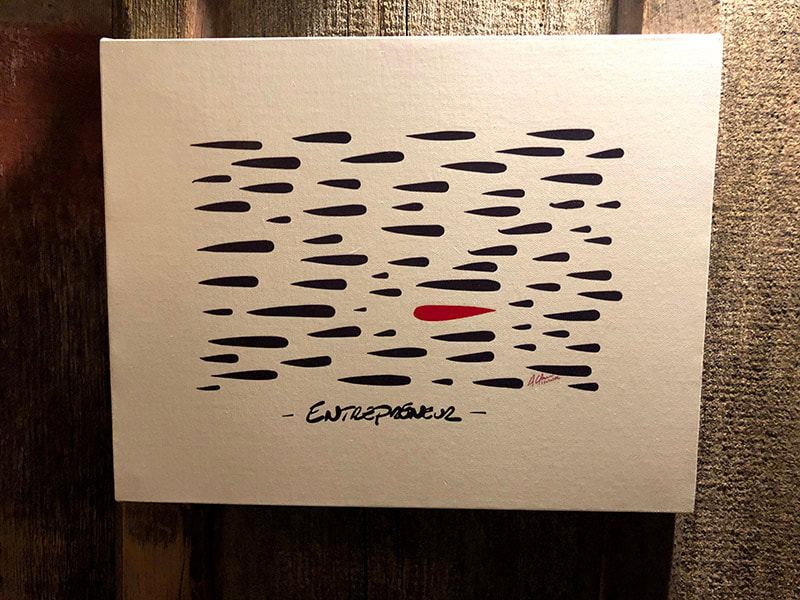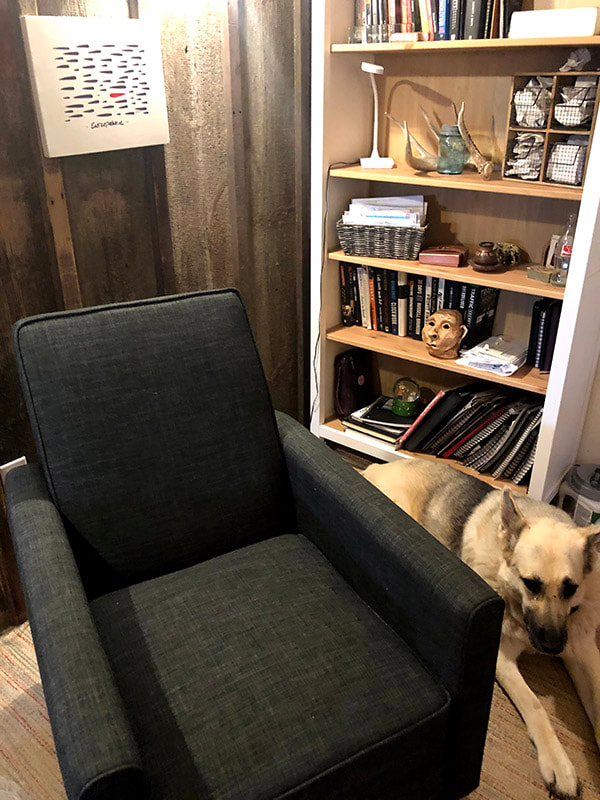
Last week I bought an accent chair for my office. This was a big deal for me. I’d been wanting a place on the main floor of our house where I could just kick back and do some reading, and I had a vision in my head for what it would look like.
It had to be comfortable, and it had to be red.
Why red? I have a canvas a client gave me hanging in my office. It’s entitled “Entrepreneur”, and it depicts one lone red drop swimming against the sea of black drops all going the opposite direction. I love that canvas, and I was convinced a red chair would be the perfect complement to tie everything in the office together.
It took me three days to choose the chair. Yes, I am one of those people – the ones who peruse every option and read all the reviews. It’s so annoying, especially for my poor husband who is standing in the background saying, “Just pick the chair already!”
I picked, I purchased, and I anxiously awaited its delivery. It arrived yesterday while I was on a call with my business coach. I wasn’t expecting it for another two weeks, so I was really excited. I couldn’t wait for my husband to get home and haul it inside so we could get it out of the box and set it up. Little did I know, I was in for a big surprise.
The Great Unboxing
To make a long story short, when we peeled back the flaps of the box and pulled the chair out, there was one glaring problem.
My red chair wasn’t red. It was blue.

Although the box, the mailing label, and the packaging slip said red, the chair itself had not gotten the memo. It’s truly a lovely chair, but it’s not what I ordered. I’m one of the most non-confrontational people in the world, my initial reaction was to try to rationalize just keeping the blue chair.
Blue is a nice color.
The chair itself is the perfect size for the space.
This chair is HERE right now. I can just make it work.
I hate to bother someone about it.
It would just be easier to keep the blue chair, even if it wasn’t what I really wanted. This is when my husband stepped in.
“Call the company. Get the red chair.” He’s a wise man.
I called the company. I ordered the red chair. Everything was resolved quickly, and we all had a good laugh about my “red” chair. Later that evening, the whole experience reminded me of a question someone asked me last week.
Is Knowing the Audience’s Pain Points Enough to Get Them to Convert?
The question made me consider my red chair situation from another angle. Instead of being on the copywriting end of things, in this instance I was the one with the problem that needed a solution. My pain points were:
- The blue chair didn’t match my vision for my office.
- I now had a blue chair instead of the red chair I wanted.
- I’d have to either settle or wait for a red one to come.
- How inconvenient was it going to be to rectify the situation?
- What would I do with the blue chair now?
When I called the company, the woman I spoke to was so nice.
“Oh, I’m so sorry that happened! That must have been so disappointing for you to open the box and not get what you wanted,” she said.
She completely knew and understood my pain points. She mirrored them back to me in her response. If she had stopped there though, I’d have still walked away in pain and probably never shopped with that company again.
The answer to the question above is no. Knowing the audience’s pain points is not enough to get them to convert. In fact, knowing them and doing nothing about it is WORSE than not knowing them at all. Why? Because to the audience, it feels like you don’t care and are choosing to purposefully leave them in pain.
When you address pain points in sales copy but don’t lead the reader to the solution, you’re leaving them worse off than when they started.
In addition to knowing and understanding an audience’s pain points, there are three things you must do in your sales conversion copy in order to get them to buy. Let’s break all three down right now.
Connect, Connect, Connect
Pain-centric sales copy can feel practically abusive if there’s no personal connection there. If the audience only feels beat to death with their problems and shortcomings, they’ll walk away defeated and definitely won’t buy. Instead, make sure you’re connecting with them in a way that shows you’re on their side. Here are a couple examples of pain points without, and then with, connection.
Without: “Stop wasting all your time on supplements that don’t work. You’re only putting fillers and chemicals into your body. That’s such a bad choice. How could you keep doing that to yourself? You really need to buy Super Health 5000.”
With: “There’s a secret nobody talks about when it comes to the supplements we put in our bodies. I couldn’t believe it when I learned it, and I don’t want you to be in the dark about it either. Here’s the truth – most supplements contain mostly fillers and even synthetic chemicals that don’t provide any healthy benefits. The good news is, there is a supplement out there that not only contains all the good stuff, but it DOESN’T use any fillers or synthetic chemicals. Want to know what it is?”
Let Them Off The Hook
If your audience is struggling with a problem that you can solve, just go ahead and let them off the hook. They’ve likely been carrying around some self-doubt and blame as they watch other people get the results they want. They’re thinking things like “Maybe it’s just me. I’m the only one who can’t figure this out.”
One of the most powerful things your copy can do for the reader is come alongside and show them that it’s not all their fault and give them hope that a real solution exists to the pain points they feel. This might sound something like this:
“Listen, you’re not the only one who’s been fed a lie about the supplements you put in your body, and it’s NOT your fault. Most drug companies sweep this information under the rug and hide it there. You’re not the only one who’s been filling their bodies with fillers and synthetic chemicals for years without even realizing it. Here at Super Health 5000, we believe in 100% all-natural supplements that contain only the most pure nutrients available.”
Lead Them To The Offer
The last strategy I want to mention that’s vital to use with pain points seems very obvious, but you’d be surprised how many copywriters gloss this over and don’t give it the attention it deserves.
Once you’ve shown them that you know and understand their pain points, connected with them as an ally, and let them off the hook for what they didn’t have or know, it’s time to take them by the hand and lead them to the real solution they’ve been looking for – the offer.
Pain points are a very effective way of capturing attention, but it’s the RESULT that makes the sale. You can point out pain points all day long, poke holes in what they’ve tried already until the cows come home, and let them off the hook until you’re blue in the face … but if you don’t clearly direct them to the logical next step, they will not buy.
“That’s ridiculous Christa! Of course they will. It’s so obvious!”
Maybe to you it is, but remember, you are much further along in your journey in terms of your offer than they are. Always work to connect the pain points with the offer by clearly showing the result they can expect and how they can take action and get their hands on it.
When you take the audience’s pain points and partner them up with these three steps, you’re guiding the audience logically towards the offer. It becomes the next logical step for them, and that’s exactly where you – and your clients – want them.
More from Christa Nichols
Want to learn more about zeroing in on exactly what the audience thinks, needs, and wants so you can write sales copy that really dials in on exactly what they need to hear to convert? Grab my FREE Target Market Mastery guide by clicking here.
